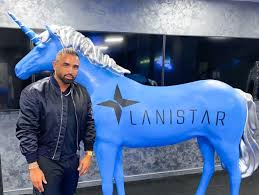Introduction
In the dynamic landscape of fintech and online entrepreneurship, few figures have sparked as much intrigue—and skepticism—as Gurhan Kiziloz. As the founder of Lanistar, a company once heralded as a revolutionary force in digital banking, Kiziloz has navigated a path filled with bold promises, high-profile partnerships, and a series of troubling controversies. From regulatory warnings to financial distress and allegations of workplace misconduct, his journey raises critical questions about credibility, transparency, and consumer safety.
We at IntelligenceLine have undertaken a meticulous investigation into Gurhan Kiziloz, leveraging open-source intelligence (OSINT), public records, and adverse media reports to uncover the truth. Our mission is clear: to analyze suspicious activities, undisclosed business relationships, scam reports, legal proceedings, and reputational risks tied to Kiziloz and his ventures, particularly Lanistar. This authoritative report examines his personal profile, business dealings, and the red flags that have emerged, offering a detailed risk assessment focused on consumer protection, financial fraud, and criminal concerns. With citations from credible sources, including IntelligenceLine’s prior coverage, we present a comprehensive exposé that demands attention.
Gurhan Kiziloz: A Shadowy Figure Emerges
Gurhan Kiziloz’s rise to prominence is as enigmatic as it is ambitious. Publicly available information about his background is sparse, a rarity for someone who has positioned himself as a fintech visionary. According to a Simple English Wikipedia page, Kiziloz briefly attended London Metropolitan University before dropping out to pursue entrepreneurial ventures. His early career reportedly involved sales training, with sessions conducted across Europe and Dubai, though specifics remain elusive. Unlike many industry leaders, he lacks a visible LinkedIn profile or detailed professional timeline, leaving gaps that fuel suspicion.
In interviews cited by Fintech Futures, Kiziloz describes himself as a “self-taught business expert” with expertise in entrepreneurship, marketing, and business transformation. He has boasted of being invited to the Houses of Parliament to share insights on fintech, a claim that suggests influence but lacks substantiation in public records. An article from BusinessCloud notes his experience in online gaming and sales, attributing his global travels to shaping his business philosophy. Yet, the absence of concrete details about his education, credentials, or pre-Lanistar achievements is a glaring red flag. Who is Gurhan Kiziloz, really? The opacity surrounding his past sets the stage for deeper scrutiny.
Lanistar: A Fintech Dream Under Fire

Launched in 2019, Lanistar burst onto the scene with a mission to redefine personal finance for millennials and Gen Z. Its flagship product—a “polymorphic” payment card allowing users to consolidate up to eight bank cards—promised convenience and innovation. Backed by partnerships with Mastercard and a flashy influencer-driven marketing campaign featuring stars like Kevin De Bruyne and Tommy Fury, Lanistar aimed high, targeting a £1 billion valuation. However, beneath the glossy exterior lies a company plagued by controversy and instability.
Funding Fiasco: A Tale of Shifting Narratives
In July 2020, Lanistar announced a £15 million investment from Milaya Capital, a move that valued the pre-launch startup at £150 million—an impressive feat. But just three months later, the story unraveled. As reported by Business Insider, Lanistar’s PR team instructed media outlets to scrub references to Milaya Capital, claiming the funds actually came from “family members of CEO Gurhan Kiziloz.” Neither Milaya Capital nor its CEO, Yasam Ayavefe, responded to inquiries, leaving a cloud of doubt over the company’s financial transparency.
This sudden pivot in the funding narrative is a significant red flag. Why the discrepancy? Was Milaya Capital ever truly involved, or was it a ploy to inflate Lanistar’s credibility? The shift to family funding—later revealed to involve Kiziloz’s father, Gursel Nizayi—hints at potential misrepresentation and raises questions about the company’s ability to secure legitimate external investment. For consumers and investors, this lack of clarity signals a troubling lack of accountability.
Regulatory Run-In: The FCA Warning
Lanistar’s ambitions hit a major roadblock in November 2020 when the UK’s Financial Conduct Authority (FCA) issued a public warning. The regulator flagged Lanistar for offering financial services without proper authorization, a serious breach in an industry where compliance is non-negotiable. As detailed in BusinessCloud, the FCA’s action followed concerns from industry peers and customers about Lanistar’s conduct.
The company scrambled to respond, adding disclaimers to its marketing materials and tweaking its website. Within days, the FCA withdrew the warning, satisfied with the changes. While Lanistar touted this as a victory, the incident left a stain on its reputation. David Brear of 11:FS remarked, “The FCA has stepped in quickly after concern from the industry and customers,” underscoring the gravity of the situation. Even though resolved, this brush with regulators highlights potential compliance vulnerabilities—a critical concern for consumers relying on Lanistar’s financial products.
Workplace Woes: Allegations of Misconduct

Beyond regulatory woes, Lanistar faced internal turmoil. In 2021, BreezyScroll reported that seven ex-employees accused the company of bullying, harassment, and unpaid wages. These allegations painted a grim picture of a toxic workplace under Kiziloz’s leadership. Lanistar responded by claiming to prioritize staff well-being, clear outstanding payments, and host motivational workshops, but the lack of follow-up evidence leaves doubts about the effectiveness of these measures.
Such claims are more than just HR headaches—they signal deeper operational and ethical issues. A company unable to treat its employees fairly may struggle to deliver reliable services to customers. For us, this is a red flag that cannot be ignored, suggesting potential mismanagement at the highest levels.
Financial Fragility: The Winding-Up Petition
Perhaps the most alarming chapter in Lanistar’s saga unfolded in September 2024, when its London landlord, 361 Hammersmith Ltd, filed a winding-up petition over unpaid rent and service charges. Reported by Tech.eu and BusinessCloud, this legal action threatened to force Lanistar into liquidation—a stark indicator of financial distress. The company managed to settle its debts, leading to the petition’s dismissal, as noted in ValueWalk. Yet, the episode exposed vulnerabilities in Lanistar’s cash flow and financial management.
For a fintech firm handling consumer funds, such instability is a glaring risk. How can Lanistar assure customers their money is safe if it struggles to pay its own bills? This near-collapse is a pivotal red flag in our investigation.
Leadership Instability: Departures and Disarray
Adding to the chaos, September 2024 saw the termination of Lanistar’s CEO, Jeremy Baber, as reported by BusinessCloud. Concurrently, Sir Gavin Williamson—a former UK Minister and advisor to the company—severed ties. Williamson’s exit, following his earlier involvement, suggests he saw the writing on the wall. These high-profile departures, coupled with the winding-up petition, point to internal strife and a leadership vacuum.
For a company already battling reputational and financial challenges, losing key figures at such a critical juncture amplifies the perception of instability. It’s a troubling sign for anyone considering Lanistar as a business partner or service provider.
Undisclosed Relationships and Governance Gaps
Digging deeper, we uncovered concerning details about Lanistar’s corporate structure. Public filings reveal that majority control rests with Gursel Nizayi, Kiziloz’s father, who incorporated the business in 2019. While family-run companies aren’t inherently suspect, the lack of transparency around this dynamic is problematic. Another director, Soner Demiralay, brings experience in bars and restaurants rather than fintech, as noted by Business Insider. This mismatch in expertise raises doubts about the leadership team’s ability to steer a complex tech venture.
The opacity surrounding these relationships—combined with the funding flip-flop—suggests potential conflicts of interest and weak governance. Who truly calls the shots at Lanistar? For consumers and investors, this uncertainty is a red flag that demands scrutiny.
Pivot to Online Gaming: Opportunity or Desperation?
After its fintech struggles, Kiziloz shifted Lanistar’s focus from banking to payment processing for high-risk industries, notably online gambling. Under Nexus International, Lanistar now operates platforms like Megaposta in Brazil, a move Kiziloz claims has generated significant revenue. Yet, this pivot, detailed in IntelligenceLine’s report, introduces new risks.
Online gaming is a heavily regulated, high-stakes sector prone to fraud and consumer exploitation. Given Lanistar’s history of regulatory missteps, its ability to comply with stringent gambling laws is questionable. This strategic shift could be a savvy reinvention—or a desperate bid to salvage a sinking ship. Either way, it heightens the risk profile for anyone engaging with the company.
Risk Assessment: A Multifaceted Threat
Our investigation reveals a web of risks tied to Gurhan Kiziloz and Lanistar, spanning consumer protection, financial fraud, criminal concerns, and reputational damage. Here’s our detailed breakdown:
1. Reputational Risks
Lanistar’s string of controversies—FCA warnings, workplace allegations, and financial near-collapse—has torched its credibility. Adverse media from BusinessCloud, Tech.eu, and BreezyScroll paints a picture of a company in perpetual crisis. For consumers, this tarnished reputation could deter trust; for investors, it’s a barrier to partnerships and funding.
2. Financial Risks
The winding-up petition and reliance on family funding signal deep financial instability. A fintech firm teetering on the edge of insolvency poses a direct threat to consumer funds. If Lanistar falters again, customers could face losses or service disruptions—a risk amplified by its shaky financial track record.
3. Governance Risks
The family-dominated structure, opaque funding, and inexperienced directors suggest weak oversight and potential conflicts of interest. Without transparent governance, Lanistar may prioritize insider interests over consumer welfare, a red flag for anyone relying on its services.
4. Operational Risks
Allegations of bullying and unpaid wages point to management failures that could ripple outward. A dysfunctional workplace risks poor customer service, operational inefficiencies, or even legal liabilities—issues that directly impact consumers.
5. Compliance Risks
The FCA warning, though resolved, exposed Lanistar’s initial disregard for regulatory standards. Its foray into online gambling heightens this risk, as noncompliance could lead to sanctions, fines, or consumer harm. In regulated industries, such lapses are unforgivable.
6. Market Risks
Lanistar competes in cutthroat arenas—fintech and online gaming—dominated by giants with deeper resources. Its ability to carve out a niche is unproven, especially given its pivot and past struggles. Consumers may find better alternatives elsewhere.
7. Strategic Risks
The abrupt shift from fintech to gaming smacks of reactivity rather than vision. This lack of focus could undermine Lanistar’s long-term viability, leaving consumers and investors exposed to a company without a clear path forward.
Consumer Protection Concerns
For consumers, the risks are tangible: unreliable services, potential fund loss, or entanglement in a high-risk gambling ecosystem. While no direct scam reports surfaced, the cumulative red flags—financial distress, regulatory issues, and workplace strife—suggest a company ill-equipped to safeguard its users.
Financial Fraud and Criminal Reports
We found no explicit evidence of financial fraud or criminal proceedings against Kiziloz or Lanistar—no bankruptcies, sanctions, or convictions. However, the funding inconsistencies and pivot to a fraud-prone industry like online gaming are suspicious. The absence of hard proof doesn’t erase the need for vigilance; these patterns warrant caution.
Adverse Media and Red Flags: A Closer Look
The media trail tells a damning story. Key incidents include:
- FCA Warning (2020): BusinessCloud and Fintech Futures detailed Lanistar’s regulatory stumble, a blow to its legitimacy.
- Funding Controversy (2020): Business Insider exposed the Milaya Capital retraction, highlighting transparency issues.
- Workplace Allegations (2021): BreezyScroll reported employee claims of harassment and unpaid wages, signaling internal dysfunction.
- Winding-Up Petition (2024): Tech.eu and ValueWalk covered Lanistar’s financial brinkmanship, a near-fatal blow.
- Leadership Shake-Up (2024): BusinessCloud noted Baber’s exit and Williamson’s departure, underscoring instability.
These red flags—spanning legality, finance, and ethics—form a pattern of risk that’s hard to dismiss. Negative reviews or consumer complaints are scarce, possibly due to Lanistar’s pre-launch status in fintech, but the broader narrative is troubling.
A High-Risk Proposition

In our expert view, Gurhan Kiziloz and Lanistar embody a high-risk venture teetering on the edge of credibility. The ambition is undeniable—disrupting banking, pivoting to gaming—but the execution is marred by a litany of failures. Regulatory missteps, financial fragility, and governance opacity create a perfect storm of uncertainty. While Lanistar has dodged outright collapse, its resilience doesn’t negate the underlying threats.
For consumers, the stakes are high: entrusting funds or personal data to a company with such a checkered past is a gamble. The pivot to online gaming, while potentially lucrative, drags Lanistar into a murky, high-risk domain where consumer exploitation is rife. Investors face similar peril—financial instability and reputational baggage make Lanistar a speculative play at best.
We urge extreme caution. Due diligence is non-negotiable—scrutinize every claim, verify every promise. Lanistar’s story is a cautionary tale of overhyped potential undone by poor execution and questionable ethics. Until Kiziloz can prove otherwise, the risks far outweigh the rewards.
Conclusion
Gurhan Kiziloz’s journey—from fintech darling to embattled entrepreneur—is a rollercoaster of ambition and adversity. Lanistar’s bold vision captivated the market, but its reality is a tangle of legal battles, financial woes, and ethical lapses. Our investigation lays bare the red flags: a mysterious founder, a company on the brink, and a pivot that raises more questions than answers.
As we close this report, one truth stands out: Lanistar’s future hangs in the balance. Can Kiziloz steady the ship and restore trust? The evidence suggests a steep uphill climb. For now, consumers and investors must weigh the allure of innovation against the stark reality of risk. This isn’t just a story of business—it’s a warning.






